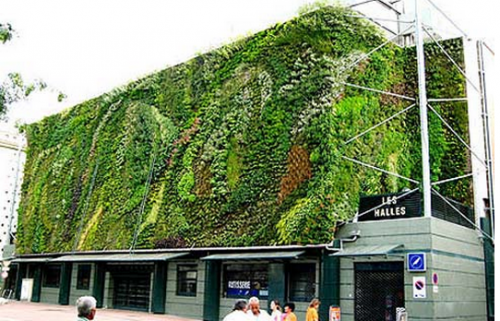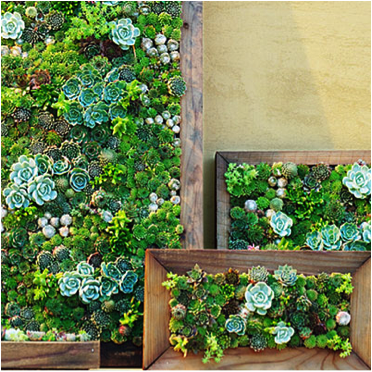Vertical gardens or living walls are a beautiful and efficient way to maximize green space within an urban context. Aesthetically, vertical gardens can be used to improve the façade of buildings while providing other ecosystem services such as enhanced air quality.
Perhaps first employed by the Mesopotamians to create the Hanging Gardens of Babylon, the principles of design have expanded past cascading plants to include plants rooted at different heights of a wall. Living walls vary in size, design, and complexity.
Two of the best-known living walls are on the Marché des Halles in Avignon and the Museé du Quai Branly, both designed by Patrick Blanc. However, man-made living walls are not constrained to grand public buildings.

It is very feasible to create you own, and in fact personal vertical gardens beautifully complement the exterior of Brooklyn brownstones, although it is recommended a professional be consulted for walls higher than 7 feet.
The character of your vertical garden is determined by the framing material and plant selection. While plant selection may vary by individual taste, native species are generally hardier and better suited to the local climate and pest and disease conditions.
Green landscaping with native species is also a proactive way to support the area’s native ecosystems. You may decide to choose a theme to guide your plant selections, such as a foliage wall, mosquito-repellant wall, epicurean wall (pick your salad ingredients!), aromatic herb wall, or a perfumed wall.
Succulents are easy plants for beginners since they do not need substantial irrigation. For vertical gardens created sans soil, epiphytes and lithophytes are necessary plant selections. Epiphytes attach to other objects solely for physical support and are not parasitic. They obtain nutrients from rain, air, and debris. Common epiphytes in temperate zones such as New York are lichens and mosses.
We will list and describe framing methods with increasing complexity.
The Woolly Packet Garden Company offers a series of “woolly packets”, pouches made from recycled water bottles with an impermeable moisture barrier and felt to wick the water. These packets are easy to install and arrange as you please. Although the design is not constrained to vertical garden use, the pouches lend themselves well to such installations. Watch this video for further description:
Flora Grubb Gardens is featuring an example vertical garden installation in their store.

For a more complex system, pre-made frames are available for sale from several manufacturers. Gro-Wall offers easy to stack frames.
VGM also offer green wall modules. Drip irrigation coupled with the effects of gravity water the plants in both systems, although this can also be adapted.
Our favorite option at Eco Brooklyn for small walls is using salvaged pallets as a frame for a living wall. We are currently creating a wooden pallet living wall installation in the Green Showroom. Simple and effective, this method limits the amount of new material needed for the project and decreases life cycle emissions and cost.

Pallets can often be found for free at local gardening stores. Pallets without significant back support may need to be augmented with scrap wood on the back. You can then staple landscaping paper to the back, bottom, and sides to create a secure void for the soil. Soil is poured through the slats and the selected plants are then planted in place and watered. Once planted, the pallet needs to remain horizontal for one to two weeks until the roots can take and stabilize the soil.
There are two easy ways to create your own frame.
The second method does not require the additions of any soil!

Method 1: Cut 4 pieces of lumber to the desired length and nail them together at the corners to create a box frame. Staple or nail wire mash to the front face of the frame and a piece of plywood to the back face. Fill the void with soil and then poke the stems from plant cuttings through the mesh. Allow the installation to remain horizontal until the plants are securely rooted. Water lightly or use a drip irrigation system. For smaller frames, it may be easiest to lay it flat when watering and allow the soil to drain before hanging it back up.
Note that the above method works best for small frames, as it does not require a complex irrigation or fertilizer system.
Method 2: This last method is the most involved in terms of infrastructure but very rewarding. It isn’t that green either since it requires a pump. It is however the most popular system and many massive walls have been created this way.
Noémie Vialard’s book Gardening Vertically offers a more in-depth description of the process, which was initially developed by Patrick Blanc. While it is possible to make a portable system, it is most effective as a permanent display.
Wooden battens are first fixed to the selected wall space, and then a PVC panel and two layers of irrigation matting are added over the battens. The irrigation system consists of a perforated pipe connected to a pump, which activates a couple times a day for a few minutes.
Nutrients can be diluted into the water tank to fertilize the ecosystem. The plant roots are inserted through holes in the second layer of felt (such that the plant is secured between layers of irrigation matting).
Because the system has no soil substrate, there is no water retention. To mitigate the high water usage, you may want to plant perennials at the foot of the wall to consume surplus water or create a fish pond at the base. Use gray water to irrigate if possible.
Apart from the electric load, this system is not sustainable in another way: if you stop the pump the plants die quickly since there is no humid soil to keep them. In that sense it is a very artificial environment. The closest natural habitat is a rock wall in a tropical jungle.
For this reason we prefer the soil based living walls. We build our own structure instead of buying pre-made products because it allows us to save costs and customize to the space.
A vertical garden installation can beautifully augment the aesthetic value of your home. Living walls do not need to be grandiose or complex and the concept can easily be adapted to personal usage. Outdoor walls are easier because you don’t have to worry about flooring issues in the house. But indoor walls, provided they get sunlight, don’t get blasted by weather extremes. Indoor walls need special attention to avoid mold issues, but if that is under control they add a freshness to the air that is wonderful.
Eco Brooklyn is a living wall installer because we really love what a living wall does to a space. It fits perfectly with our mission to turn NY green!
